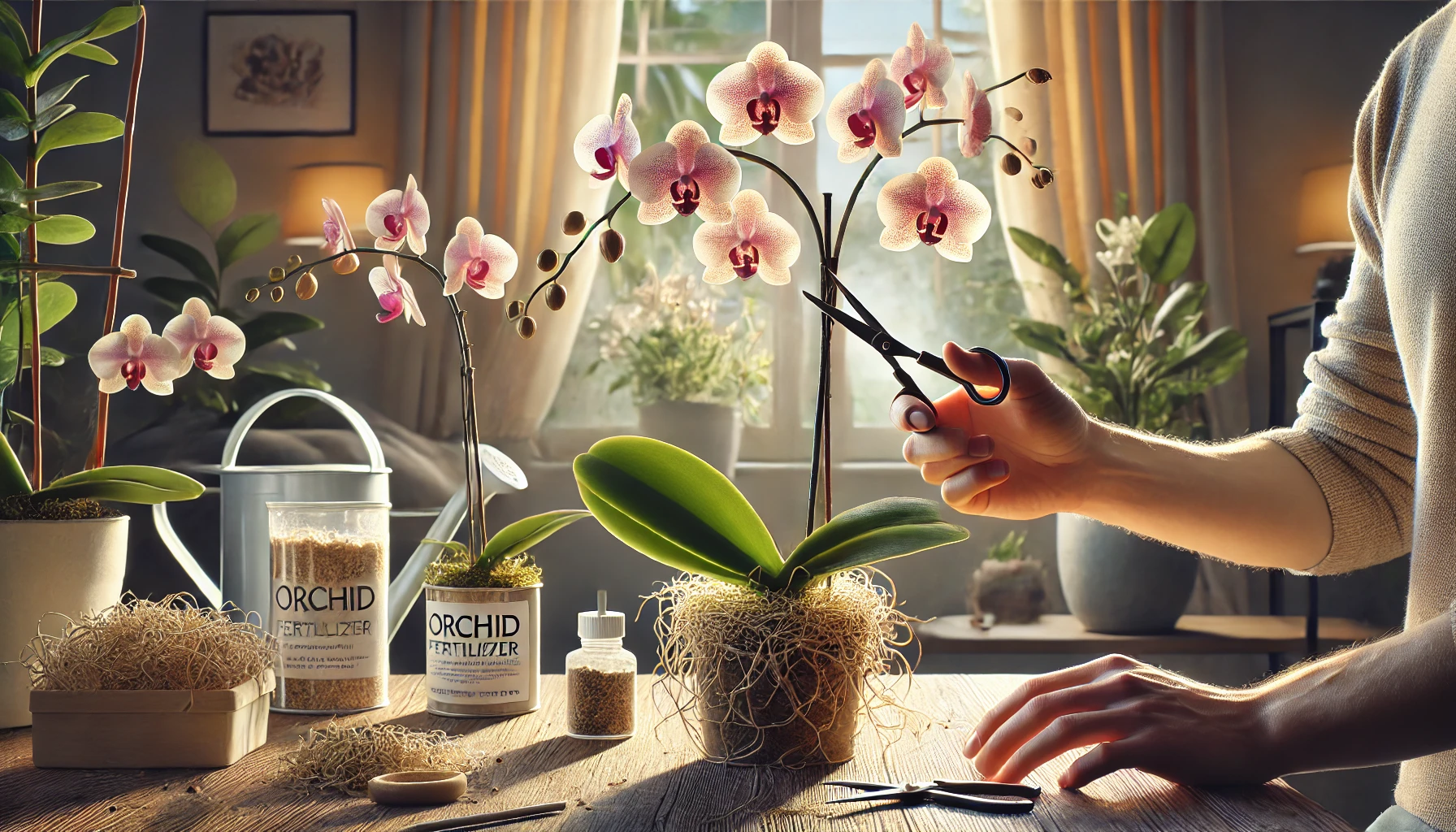When an orchid’s flowers fade and fall, many growers wonder what to do next. Some people mistakenly believe their plant is dying and discard it, but in reality, orchids go through a natural rest period before blooming again. With the right care, your orchid will regain energy and eventually reward you with another round of beautiful flowers.
🌱 What Happens After an Orchid Stops Blooming?
Orchids don’t bloom continuously. Once the flowers fall, the plant enters a resting phase (dormancy), during which it focuses on growing new leaves and roots. This stage is crucial for building up the energy needed for future blooms.
✔ Signs Your Orchid Has Entered Its Resting Phase:
- All flowers have dropped from the spike.
- The plant continues growing new leaves or roots.
- The flower spike stays green or turns brown.
💡 Dormancy is normal! With the right care, your orchid will bloom again in a few months.
✂️ Step 1: Should You Cut the Flower Spike?
Once an orchid has finished blooming, you have three options for handling the flower spike, depending on its condition.
✔ If the spike is still green:
- Trim just above a node (bump on the spike) to encourage a possible second bloom.
- This method works best for Phalaenopsis orchids, which sometimes rebloom from the same spike.
✔ If the spike is turning brown or yellow:
- Cut it at the base, as it won’t bloom again.
- This allows the orchid to focus its energy on new growth.
✔ If you’re unsure:
- Wait a few weeks and observe—if the spike stays green, leave it. If it starts drying out, trim it at the base.
💧 Step 2: Adjust Your Watering Routine
During the resting phase, orchids need less water than when they are actively blooming. Overwatering can lead to root rot and weaken the plant.
✔ Reduce watering to every 7–10 days, letting the roots dry slightly between waterings.
✔ Water in the morning to allow moisture to evaporate throughout the day.
✔ Always use room-temperature water and let excess moisture drain completely.
🌞 Step 3: Provide the Right Light and Temperature
Although your orchid isn’t blooming, it still needs bright, indirect light to stay healthy. Too little light will prevent future flowering, while too much direct sun can scorch the leaves.
✔ Keep the orchid in an east or north-facing window for gentle light.
✔ Use a sheer curtain to filter harsh sunlight if placed in a south-facing window.
✔ Maintain a temperature range of 65–75°F (18–24°C) during the day and a slight drop at night to encourage future blooms.
🍃 Step 4: Feed Your Orchid for Strong Growth
Even though your orchid isn’t flowering, fertilizing during dormancy helps build strength for the next bloom cycle.
✔ Use a balanced orchid fertilizer (20-20-20) at half strength once a month.
✔ If new roots and leaves appear, increase feeding to twice a month.
✔ Stop fertilizing if the orchid isn’t showing any new growth.
💡 Switch to a bloom-boosting fertilizer (10-30-20) when you notice a new flower spike forming.
🏺 Step 5: Check if Your Orchid Needs Repotting
Orchids don’t need frequent repotting, but after blooming is a good time to check if it needs fresh potting mix.
✔ Repot if:
- The potting medium has broken down or retains too much moisture.
- Roots are growing out of the pot or looking crowded.
- The plant is unstable and leans to one side.
✔ How to Repot an Orchid:
1️⃣ Remove the orchid from its pot and shake off old potting mix.
2️⃣ Trim any black, mushy, or dead roots using sterilized scissors.
3️⃣ Choose a new pot with drainage holes, slightly larger than the root system.
4️⃣ Fill with fresh orchid bark mix, positioning the plant securely.
5️⃣ Water lightly and keep the orchid in a shaded spot for a few days to adjust.
🌡 Step 6: Encourage Reblooming
Most orchids bloom once a year, but you can help trigger flowering by mimicking their natural environment.
✔ Create a temperature drop at night:
- Lower nighttime temperatures to 55–65°F (13–18°C) for several weeks.
- This signals the orchid to start forming a new flower spike.
✔ Ensure enough light exposure:
- Orchids need bright, indirect light to initiate blooms.
- If needed, use a full-spectrum grow light for at least 10–12 hours a day.
✔ Switch to a bloom-boosting fertilizer:
- When a new flower spike appears, switch to 10-30-20 fertilizer to support flowering.
🚫 Common Mistakes to Avoid After Blooming
❌ Overwatering: Dormant orchids need less water—always check the roots before watering.
❌ Leaving a dead spike: If the spike turns brown, trim it to redirect energy to new growth.
❌ Ignoring light needs: Even when not blooming, orchids still require bright, indirect light.
❌ Not checking roots: Repot if the potting mix is decomposed or holding too much moisture.
🛡 Final Tips for Post-Bloom Orchid Care
✔ Be patient—orchids can take months to rebloom, depending on the species.
✔ Keep the orchid in a consistent, stable environment.
✔ Monitor new root and leaf growth as a sign of a healthy plant.
✔ Once a new flower spike forms, avoid moving the orchid, as sudden changes can cause bud blast.
With the right post-bloom care, your orchid will regain strength and eventually bloom again, bringing beauty to your home year after year! 🌸✨
